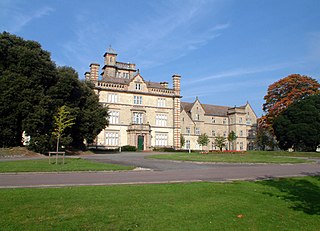
Wychbold is a village in the Wychavon district of Worcestershire. The village is situated on the A38 between Droitwich Spa and Bromsgrove, and by Junction 5 of the M5 motorway.

Powick is a village and civil parish in the Malvern Hills district of Worcestershire, England, located two miles south of the city of Worcester and four miles north of Great Malvern. The parish includes the village of Callow End and the hamlets of Bastonford, Clevelode, Collett's Green, and Deblins Green.

Fulbourn Hospital is a mental health facility located between the Cambridgeshire village of Fulbourn and the Cambridge city boundary at Cherry Hinton, about 5 miles (8 km) south-east of the city centre. It is managed by the Cambridgeshire and Peterborough NHS Foundation Trust. The Ida Darwin Hospital site is situated behind Fulbourn Hospital. It is run and managed by the same trust, with both hospitals sharing the same facilities and staff pool.
George Thomas Hine FRIBA was an English architect. His prolific output included new county asylums for Hertfordshire, Lincolnshire, Surrey, East Sussex and Worcestershire, as well as extensive additions to many others.

Claybury Hospital was a psychiatric hospital in Woodford Bridge, London. It was built to a design by the English architect George Thomas Hine who was a prolific Victorian architect of hospital buildings. It was opened in 1893 making it the Fifth Middlesex County Asylum. Historic England identified the hospital as being "the most important asylum built in England after 1875".

Powick Hospital, which opened in 1847 was a psychiatric facility located on 552 acres (223 ha) outside the village of Powick, near Malvern, Worcestershire. At its peak, the hospital housed around 1,000 patients in buildings designed for 400. During the 1950s the hospital gained an internationally acclaimed reputation for its use of the drug LSD in psychotherapy pioneered and conducted by Ronald A. Sandison. In 1968 the institution was surrounded by controversy concerning serious neglect of patients. In 1989 it was closed down leaving Barnsley Hall Hospital in Bromsgrove as the remaining psychiatric hospital in the county. Most of the complex has been demolished to make way for a housing estate.

Cefn Coed Hospital is a mental-health facility in Swansea, Wales. It is managed by the Swansea Bay University Health Board.

Bootham Park Hospital was a psychiatric hospital, located in the Bootham district of York, England. It was managed by the Tees, Esk and Wear Valleys NHS Foundation Trust. The main building is a Grade I listed building.
The Commissioners in Lunacy or Lunacy Commission were a public body established by the Lunacy Act 1845 to oversee asylums and the welfare of mentally ill people in England and Wales. It succeeded the Metropolitan Commissioners in Lunacy.

The Hellingly Hospital Railway was a light railway owned and operated by East Sussex County Council, used for transporting coal and passengers to Hellingly Hospital, a psychiatric hospital near Hailsham, from the London, Brighton and South Coast Railway's Cuckoo Line at Hellingly railway station.

The Mid Wales Hospital was a psychiatric hospital in Talgarth, Wales.

Fairfield Hospital in Fairfield, Bedfordshire, England was a psychiatric hospital from 1860 to 1999. It is a Grade II listed building.

Hellingly Hospital, formerly the East Sussex County Asylum, was a large psychiatric hospital close to the village of Hellingly, east of Hailsham, in the English county of East Sussex.

West Park Hospital was a large psychiatric hospital in Epsom, Surrey.

Horton Hospital, formerly called Horton Asylum, was a large psychiatric hospital in the Horton area of Epsom, Surrey.

Middlewood Hospital is a former psychiatric hospital situated between the suburbs of Middlewood and Wadsley in the City of Sheffield, South Yorkshire, England. It was also known as the South Yorkshire Asylum (1872–1888), the West Riding Asylum, Wadsley (1889–1929) and Wadsley Mental Hospital (1930–1948). It was one of four hospitals that made up The West Riding General Asylums Committee. It closed in 1996 and is now a private housing development called Wadsley Park Village.

Rainhill Hospital was a very large psychiatric hospital complex that was located in Rainhill, Merseyside, England.
Healthcare in Worcestershire was the responsibility of three Clinical Commissioning Groups until July 2022, covering, respectively Redditch and Bromsgrove, Wyre Forest and South Worcestershire.

Fair Mile Hospital was a lunatic asylum built in 1870 in the village of Cholsey, 2 miles (3 km) south of Wallingford and north of Moulsford. The asylum was built next to the River Thames between Wallingford and Reading, formerly in Berkshire but, following the boundary changes of 1974, now in Oxfordshire.
Ronald Arthur Sandison was a British psychiatrist and psychotherapist. Among his other work. he is particularly noted for his pioneering studies and use of lysergic acid diethylamide (LSD) as a psychotheraputic drug. As a consultant psychiatrist, his LSD work was mainly carried out during the 1950s and '60s at Powick Hospital, a large psychiatric facility near Malvern, Worcestershire, after which he spent several years in Southampton, where he was instrumental in the establishment of the university medical school. He returned to his native Shetland Isles in the 1970s and worked in psychotherapy there. He later specialised in psychosexual medicine on the UK mainland. Sandison died at the age of 94, and was buried in Ledbury near Malvern.

















